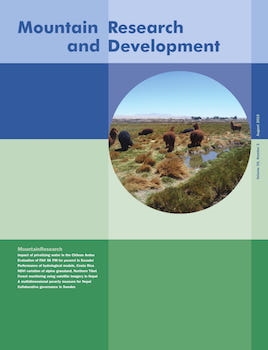Forêt et montagne [Forests and Mountains] by Groupe d’Histoire des Forêts Françaises. Compiled and presented by Andrée Corvol, Charles Dereix, Pierre Gresser, and François Lormant. Paris, France: L’Harmattan, 2015. 411 pp. € 34.50. ISBN 978-2-343-05523-7.
The “Group for French Forest History” (Groupe d’Histoire des Forêts Françaises) was created in Paris in 1982 as an independent scientific network aiming to promote better knowledge of the history of forests and their uses in France. It now comprises some 200 French scientists and foresters and organizes seminars and workshops that address special issues related to the links between forests and society. This book is the proceedings of a seminar held in Chambéry in September 2012 on the topic of mountain forests. It includes 22 chapters, mainly from historians, geographers, and foresters, most of them from France. This series of papers does not aim to provide a rigorous scientific contribution to the analysis of a possible specificity of the mountainous context for forest management and governance. Rather, it illustrates facts and figures in the light of space- and time-based case studies. Most of the examples come from the French mountainous areas of the Alps, Jura, and Vosges, complemented by papers from Bulgaria, Italy, Spain, and Switzerland.
While reading through these stories, the overall evolution that has affected Europe’s mountain forests (as well as other forested cultural landscapes) through history becomes apparent as an underlying theme. A first traditional model of land use, resulting from progressive human settlement after the clearing of an increasing proportion of the initial forest, and associated with self-sufficient agriculture, grazing of cattle and sheep, and collection of forest products, emerged from the Middle Ages and became widespread, without significant changes, until the end of the 18th century. This model was radically affected by the rural depopulation occurring from the mid-19th century onward, which led to the abandonment of large areas of previous agricultural land. It was replaced by a productivist economic model, in which the marketing of wood-based products (fuelwood, charcoal, timber) could bring more income to the remaining farmers, as well as to wider society, than a weak subsistence agriculture. For some decades, this model of wood production has, in its turn, been progressively replaced by another framework based on the importance of the provision of “nature” in the tourism economy. In this new model, which sometimes coexists with the previous one, mountain forests are perceived as “natural” scenery that brings relevance, profitability, and social acceptance to recreation activities. Thus, the mountain forest exists per se, and no more through its direct production of goods. In the course of this last transformation, the stakeholders involved in rural development and policy are changing, not always to the benefit of local actors. The variety of ecological and socioeconomic contexts described in the papers shows better than any theory how the policy measures and management tools need to be adapted, case by case, to local situations.
Some interesting contributions revisit the well-known story of the French “restoration of mountain terrain” (restauration des terrains en montagne, often referred to by the acronym RTM). Launched in the mid-19th century, this has been one of the major state interventions in France, its aim being to control the use of mountain forests and pastures by mountain people. No new facts or figures emerge from these papers, except maybe a modern rehabilitation of the state’s role in conserving forests and mountains, although the foresters’ strategy was very much criticized, both socially and politically, when the policy was established and implemented. The related papers underline the French forest service’s proactive understanding of the public interest but do not consider whether this state control might have contributed, in conjunction with a liberalized and globalized economy, to the decline of mountain forests in France.
Although the book calls for a multidisciplinary approach to forest history, almost all contributions are disciplinary. The resulting mosaic of assessments and viewpoints sometimes gives the impression of a discontinuity between the past and the present, which is obviously not the purpose of the publication. The economic and policy challenges that directly affect the future of France’s mountain forests are described partially in several chapters, but contributions by social and political scientists remain very limited, if not absent. This may restrict the capacity of researchers working on mountain forests to provide advice on policy decisions at the various levels of governance and management. Overall, the state of the art provided by these proceedings shows that there is still a lot of research to be done—especially in the fields of social, economic, and political history—to bridge the gap between scientists’ knowledge and practitioners’ demands.
Open access article: please credit the authors and the full source.





